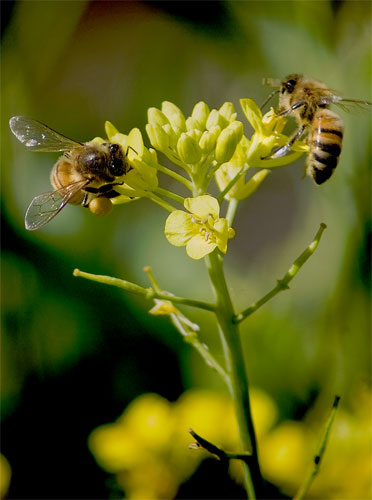For The Birds And Bees: It’s National Pollinator Week
June 19, 2011
This week goes to the birds and the bees – and to all of the other pollinators that keep our world growing and productive. June 20-26 is National Pollinator Week, and its intent is to raise awareness of the importance of pollinators to plants, animals, and humans.
 As pollinators gather nectar and pollen for their survival, they are responsible for the reproduction (the production of fruits, seeds, nuts, etc.) of 70 percent of all flowering plants and two-thirds of crop plants. This ecological service is worth $14.6 billion annually in the United States, quite a chunk of change for this diverse batch of insects, birds and mammals.
As pollinators gather nectar and pollen for their survival, they are responsible for the reproduction (the production of fruits, seeds, nuts, etc.) of 70 percent of all flowering plants and two-thirds of crop plants. This ecological service is worth $14.6 billion annually in the United States, quite a chunk of change for this diverse batch of insects, birds and mammals.
Unfortunately, many of the world’s pollinators are at risk. Studies have shown that about a third of the nation’s managed honeybee colonies are lost each year, a trend that has held steady for the past five years. Pesticides and other toxins have also reduced the number of butterflies and other crucial pollinators.
But it’s not all gloom. An army of agencies and nonprofit groups have assembled to help restore and protect pollinator populations. And there are things you can do in your very own yard to help pollinators flourish.
First, you can incorporate pollinator friendly plants into your landscape. A diverse planting of mostly native plants is typically best. By diverse, we mean use of flowers with different shapes, colors and times of bloom. Natives include beardtongue, coreopsis, black-eyed susan, native sunflowers, purple coneflower, beebalm, tropical sage, and milkweed.
You can also provide nesting sites for bees, called bee blocks. To make a bee block, start with preservative free lumber and drill holes 3/32 to 3/8 inches in diameter. Holes should be spaced 3/4 inches apart, and they should only be open at one end.
 Avoid using pesticides. While pesticides kill those pesky bugs, they take out a lot of beneficial bugs, too. Explore non-pesticide options when protecting yourself and your plants. Planting certain plants can ward off unwanted bugs or attract those good bugs to ward them off for you.
Avoid using pesticides. While pesticides kill those pesky bugs, they take out a lot of beneficial bugs, too. Explore non-pesticide options when protecting yourself and your plants. Planting certain plants can ward off unwanted bugs or attract those good bugs to ward them off for you.
You can also promote pollinator habitat in your community. Greenspaces like parks and golf courses can provide valuable habitat for pollinators. As urbanization continues to deplete natural lands, these green spaces can serve as sanctuaries for pollinators. Encourage your local leaders and golf course owners to use landscaping and pesticide management best suited for pollinators.
Roadsides are another resource for helping pollinators. American roadsides have 10 million acres of land that could be ideal habitat. Ask your local and state highway officials to plant or allow native vegetation to colonize roadsides, creating an aesthetically pleasing vista for motorists as well as helping pollinators.
USDA and the Natural Resources Conservation Service (NRCS) recognize the importance of pollinators. USDA Secretary Tom Vilsack designated this week as National Pollinator Week as a way to honor pollinators, “which provide significant environmental benefits necessary for maintaining healthy, biodiverse ecosystems,” Secretary Vilsack wrote in his proclamation. The NRCS promotes pollinator habitat in its cost-share programs, which gives landowners incentives to establish nectar corridors and pollinator nesting habitat.
Pollinators on the Web
For information on NRCS programs, visit www.fl.nrcs.usda.gov.
For information on pollinators, visit www.nrcs.usda.gov/pollinators .
For a copy of NRCS’ “Be Kind to Pollinators” brochure, call 1-888-526-3227.
For information on National Pollinator Week, visit www.pollinator.org.
Some other helpful sites are www.xerces.org/pollinator-conservation/ and www.abfnet.org.
Joshua McElhaney is a District Conservationist with the USDA’s Natural Resources Conservation Service (NRCS). He works in the Molino (Escambia County) Field office. For additional details contact the Escambia County, FL USDA NRCS office at (850) 587-5404 ext. 3. Located at 151 Hwy 97, Molino (Escambia County Farm Bureau Building).
Comments
2 Responses to “For The Birds And Bees: It’s National Pollinator Week”




William
Thanks sincerely for this information. We have been watching the bee’s
that frequent our flower and vegie garden. With this information
we can plant more to help out.
thanks again.
Is there a card for this? Who gets it?